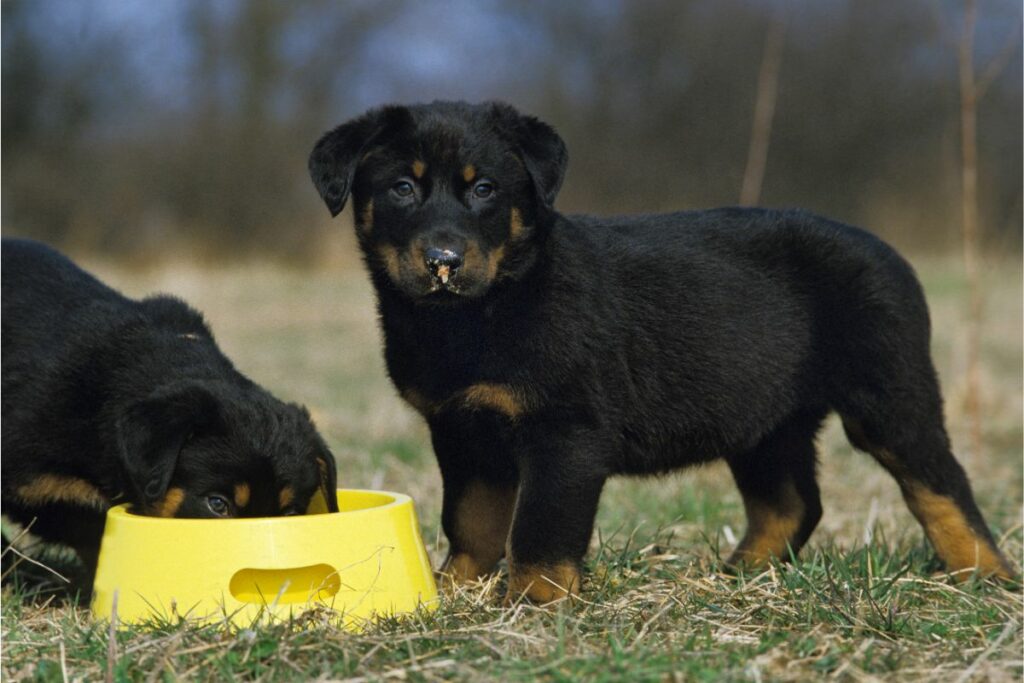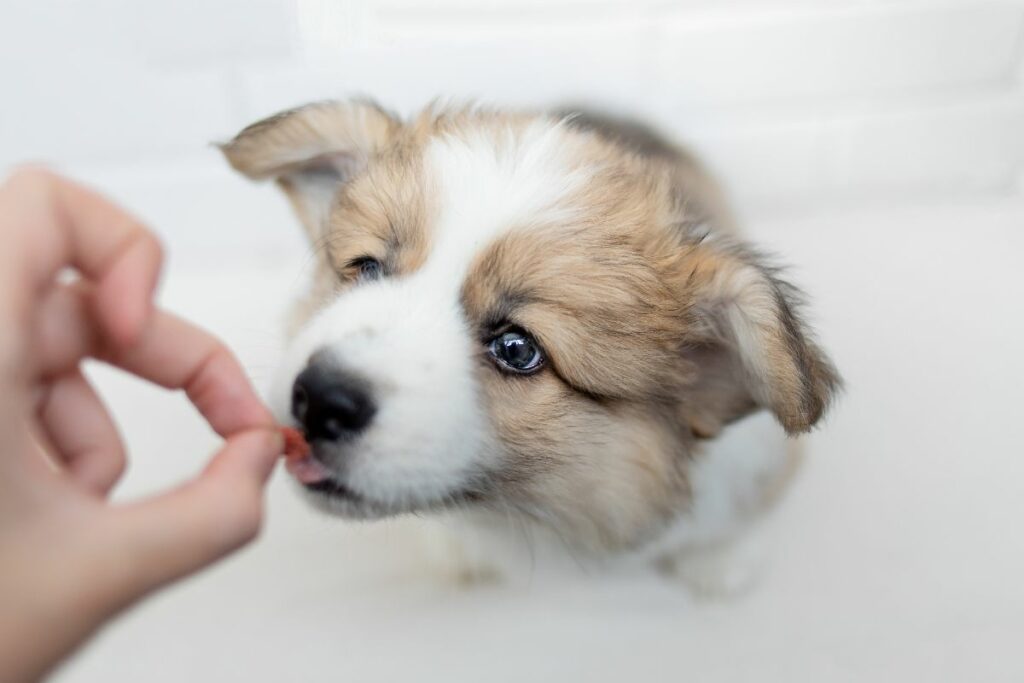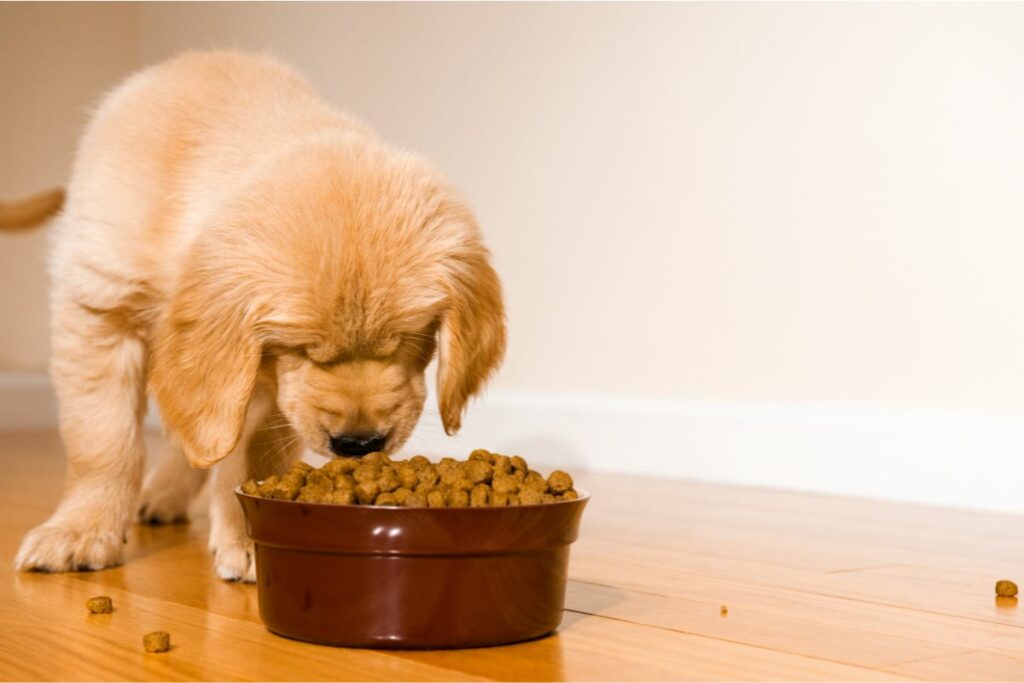You’ve got a new puppy? Congratulations!
Bringing a new bundle of fluff into your home is so exciting, but it’s also a huge responsibility.
This loveable little life is now in your hands, and it’s our job as pet owners to do the very best we can for our pets.

A key part of good dog care is feeding a good quality diet and setting a suitable feeding schedule.
In this guide, we’ll walk you through your new pup’s nutritional needs, share how often you should feed your dog, and we’ve even included some tips for those fussy pups.
Don’t worry – you’ve got this. And we’re here to help.
Choosing The Right Bowl For Your Puppy
Before you pick up your pup, you’ll want to go shopping for the essentials.
Food and water bowls should be included on your list of essentials, but with so many options, it can be a little confusing knowing what to choose.
Your pup will need two bowls – one for food and one for water. It’s best to start your pup off with a small bowl or a specific puppy bowl.
You can get something more suitable for your pup’s breed and size when it grows.
Many puppy bowls will be plastic or stainless steel – both materials are fine, but it’s worth bearing in mind that some puppies will try to use their bowls as toys and carry them around – in this case, a ceramic bowl can be better.
How Often Should You Feed Your Puppy?
Pups require more frequent meal times compared to adult dogs; they benefit from meals that are small and served often.
Small to medium-sized puppies should typically be fed three times a day, and larger breed dogs should be fed three to four times per day.
Free feeding – where food is left down throughout the day – is not recommended for pups or adult dogs.
This is because it can be harder to control their portion sizes – especially in a multi-dog household – and overgrazing can lead to obesity.
Setting a meal schedule can help your dog feel part of the family and gives them a good routine from a young age.
A typical feeding schedule for a puppy could be:
- 8 am: Breakfast – meal one
- 11 am: Brunch – meal two
- 2 pm: Lunch – meal three
- 6 pm: Dinner – meal four
As your puppy develops, you can reduce the meal frequency and feed your dog twice a day.
What Should You Feed Your Puppy?
Before we look at what to feed your pup, it’s worth understanding more about puppy nutrition.
Pups need more calories than adult dogs, and they require a different mix of nutrients to help them develop and grow.
A balanced puppy diet should contain:
- Protein: Puppies require a minimum of 22% protein in their diet.
- Fat: The diet should be around 8.5% fat.
- Calcium: Pups need plenty of calcium in their diet to develop strong bones. Their diet should contain 1.2% calcium.
- Carbohydrates: Growing pups will generally need a minimum of 20% of digestible carbohydrates.
- DHA: A balanced diet should also give growing pups DHA – an omega-3 fatty acid – to promote proper development of the brain and central nervous system.
When you choose your puppy from a breeder, be sure to ask what food they’re feeding the litter.
Puppies can have sensitive stomachs as they are still developing, so keeping the food consistent as they settle into their new home is important.
As your pup adjusts to its new environment, you can always consider changing the diet, but it’s important to do it very slowly to avoid any stomach upset.
When it comes to the wet vs. dry food debate, kibble is considered the optimal choice. Dry food – or kibble – generally offers the most complete diet for both pups and older dogs.
An added benefit of feeding a kibble diet is that it can help with dental hygiene – crunching the biscuits can help promote healthy teeth and gums.
And, for most brands of puppy food, you can choose between different kibble sizes to suit your pup. Opt for a smaller kibble for toy breeds and a larger kibble for larger pups.
A dry food diet is generally a more economical option, too, and there’s less mess.
You can moisten kibble with water or add some wet food into the mix – but you will need to reduce the amount of kibble being fed if you are adding wet food to the meal.
Regardless of whether you choose to feed wet or dry food, the key is to choose puppy food that is high quality and offers the right nutrition to support proper growth.
Some high-quality brands of dog food include:
- Purina Pro Plan
- Hill’s Science Diet
- Royal Canin
- Blue Buffalo
- The Honest Kitchen
- Merrick.

How Much Should You Feed Your Puppy?
How much food your puppy requires will very much depend upon its developmental stage and its breed – and also on the type of food you are feeding them.
Always check the guidelines on the side of the packet carefully to ensure you’re feeding the right quantity of food, and consult with your veterinarian regularly on your growing pup’s diet.
However, as a general guide, you can expect to feed your pup based on the following from Purina:
| Mature Dog Weight | 1-1/2 – 3 Months | 4 – 5 Months | 6 – 8 Months | 9 – 11 Months | 1 – 2 Years |
| 3 – 12 lbs | 1/2 – 1 cup | 2/3 – 1-1/3 cups | 1/2 – 1-1/2 cups | Feed as an adults dog | Feed as an adult dog |
| 13 – 20 lbs | 1/2 – 1-1/4 cups | 1-1/8 – 2 cups | 3/4 – 1-1/3 cups | 1 – 1-1/2 cups | Feed as an adult dog |
| 21 – 50 lbs | 1/2 – 1-1/2 cups | 1-1/2 – 2-3/4 cups | 1-1/8 – 2-1/3 cups | 2 – 3 cups | 2 – 4-1/4 cups |
| 51 – 75 lbs | 5/8 – 2-1/3 cups | 1-1/2 – 4 cups | 1-1/2 – 3-3/4 cups | 2-1/2 – 4-3/4 cups | 2-5/8 – 6-1/4 cups |
| 76 – 100 lbs | 1 – 2-2/3 cups | 2-7/8 – 3-3/4 cups | 2-7/8 – 6-1/3 cups | 3-7/8 -7 cups | 5-5/8 – 11 cups |
For puppies expected to reach an adult weight of over 100 lbs, feed an extra ⅓ of a cup of food for each 10 lb of body weight that exceeds 100 lbs.
How To Handle A Fussy Puppy
Now, while most dogs will wolf down their food (and be begging for more), it’s not uncommon to find a fussy pup.
If you’ve got a pooch that doesn’t fancy its food, take a look at these tips:
- Restrict access to anything other than their dog food – this includes treats and human food. The goal is to avoid distracting your pooch with something tastier.
- Try switching to a different type of food, but don’t be tempted to continually do this, as it can perpetuate the fussy cycle.
- Try to make the food more enticing by adding some water to kibble or a little wet food. Just be sure to mix everything in well so that your pup doesn’t just eat the wet food and leave the rest. You can also get dog gravy to top the food, but again, it’s important to make sure they don’t just lick the gravy and leave everything else.
- Dogs love praise, so when your pup does eat from its bowl, make a big fuss.
Can A Puppy Have Treats?
Puppies can start to be given treats from around eight weeks old, but it’s important to note that not all dog treats will be suitable for your little ball of fluff at this age.
Treats are a great training aid and can be used to reinforce desirable behavior.
When choosing treats, look for those that have been developed specifically for puppies.
Puppy treats are often smaller than adult dog treats, and they are softer, too, as your pup’s adult teeth haven’t yet arrived.
Your vet or your local pet store should be able to point you in the direction of the best treats for your pup.
Remember, though, treats should make up no more than 10% of your dog’s diet, so it’s important to keep them as rewards and not feed them too often.

Are There Any Human Foods I Can Give My Puppy?
You can introduce your puppy to certain human foods, but it’s important not to overdo it.
You may want to start with a small amount of lean meat as a treat or even a small portion of fruit or vegetables.
As we mentioned earlier, puppies have sensitive stomachs, so we would recommend introducing these human treats one by one.
If something causes your pup a stomach upset, stop feeding it and consult your vet.
Another thing to be aware of is that feeding human food can lead to fussiness, so it’s vital to only offer these as a treat.
View our guide on foods and other things that are safe for dogs (as well as those that aren’t) for a comprehensive list.
When Do I Put My Puppy On Adult Food?
It’s important for dogs to remain on the right diet for the duration of their puppyhood – this ensures they’re getting all the nutrients they need to grow into strong and healthy adult dogs.
The age at which you can switch from puppy food to adult food will be different and is dependent on the size of the breed.
As a general guide, toy and smaller breed puppies can move onto adult food from the age of around nine months old.
Medium-sized dog breeds usually move on to adult food at around 12 months old, and larger dogs and giant breeds may need to remain on puppy food until the age of 18 months or more.
If you’re not sure, it’s best to keep your pooch on a puppy diet for a little longer, and you can check in with your veterinarian for advice on when to make the switch.
How To Wean A Puppy Onto Adult Food
The key phrase here is ‘wean’ as it’s important not to abruptly stop feeding puppy food and switch to adult dog food without a transitional phase.
Why? Well, abrupt changes to a dog’s diet can lead to an upset stomach.
To move your pup onto adult food, you need to allow about a week.
On the first day, feed your pooch three-quarters of their normal food mixed in with a quarter of the new adult dog food.
Do this for 2-3 days and monitor your dog’s stools for any signs of stomach issues.
On days 3 to 4 or 5, as long as your puppy has adjusted well, you can feed half of each type of food.
When you reach days 5 – 7, you should be able to transition to one-quarter puppy food and three-quarters adult food.
By days 8 – 10, your pup should be fully weaned onto adult dog food.
If your puppy experiences an upset stomach at any point, you may need to slow the weaning process.

What To Do If A Puppy Gets An Upset Stomach From Its Food
Most puppies, and dogs for that matter, will suffer from an upset stomach at some point.
When this first happens, we would definitely recommend speaking to your vet.
However, in many cases, your veterinarian will recommend putting your pup on a bland diet until their stomach is better.
A bland diet often involves something like lean, boiled chicken and rice. This is easy on the stomach but will also prevent your pup from feeling hungry.
It’s important to make sure your pup is also drinking plenty of water to prevent dehydration.
In Summary
At first, feeding a puppy might feel a little overwhelming, but half of the battle is just choosing a good quality food that your pup enjoys and knowing how to feed the right amount.
You can introduce your puppy to some treats, and as it approaches full size, you can start to wean it onto a diet for adult dogs.
- The Ultimate Puppy Feeding Guide For New Owners - August 30, 2023
- A Guide To Group Dog Obedience Training - August 28, 2023
- A Guide To Total Immersion Board And Train - August 24, 2023
